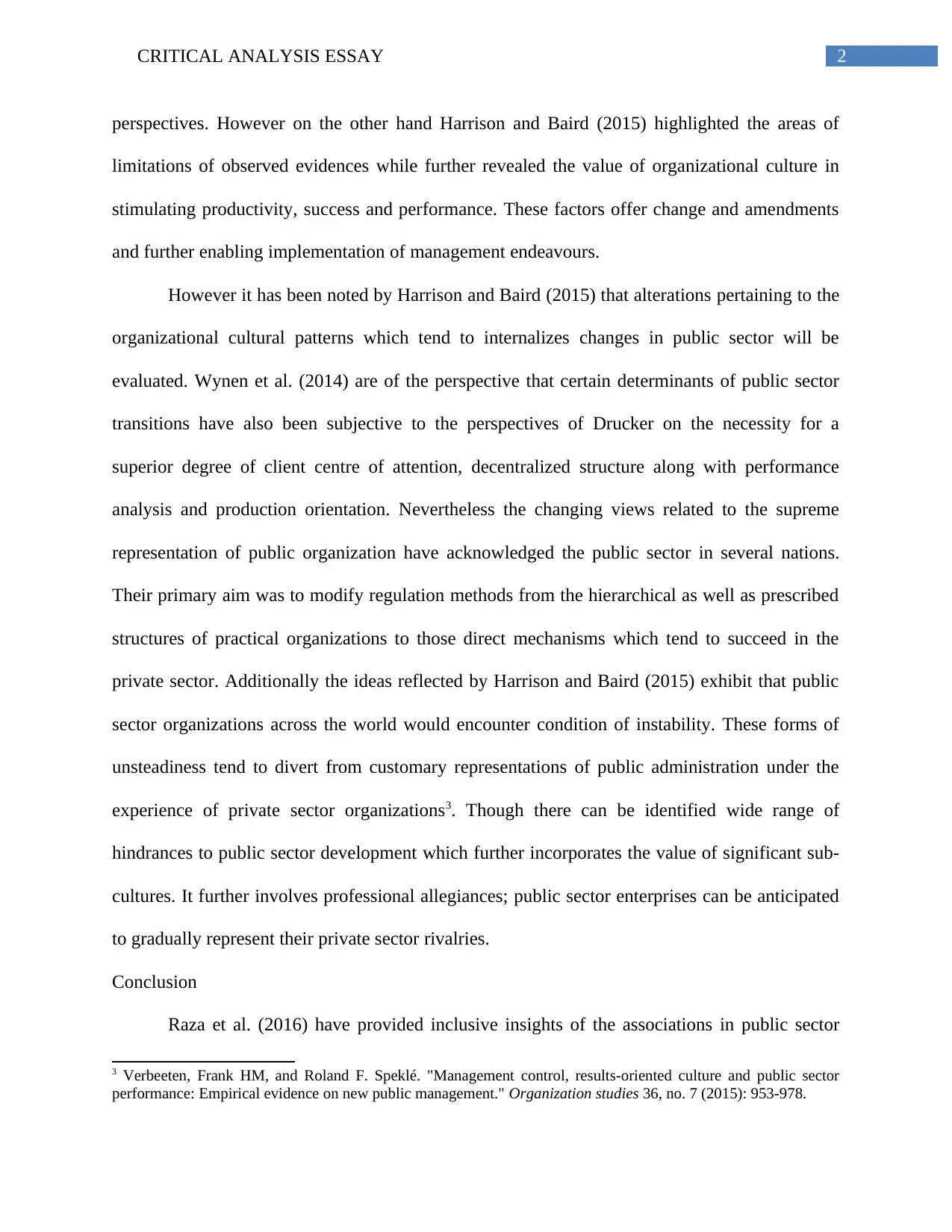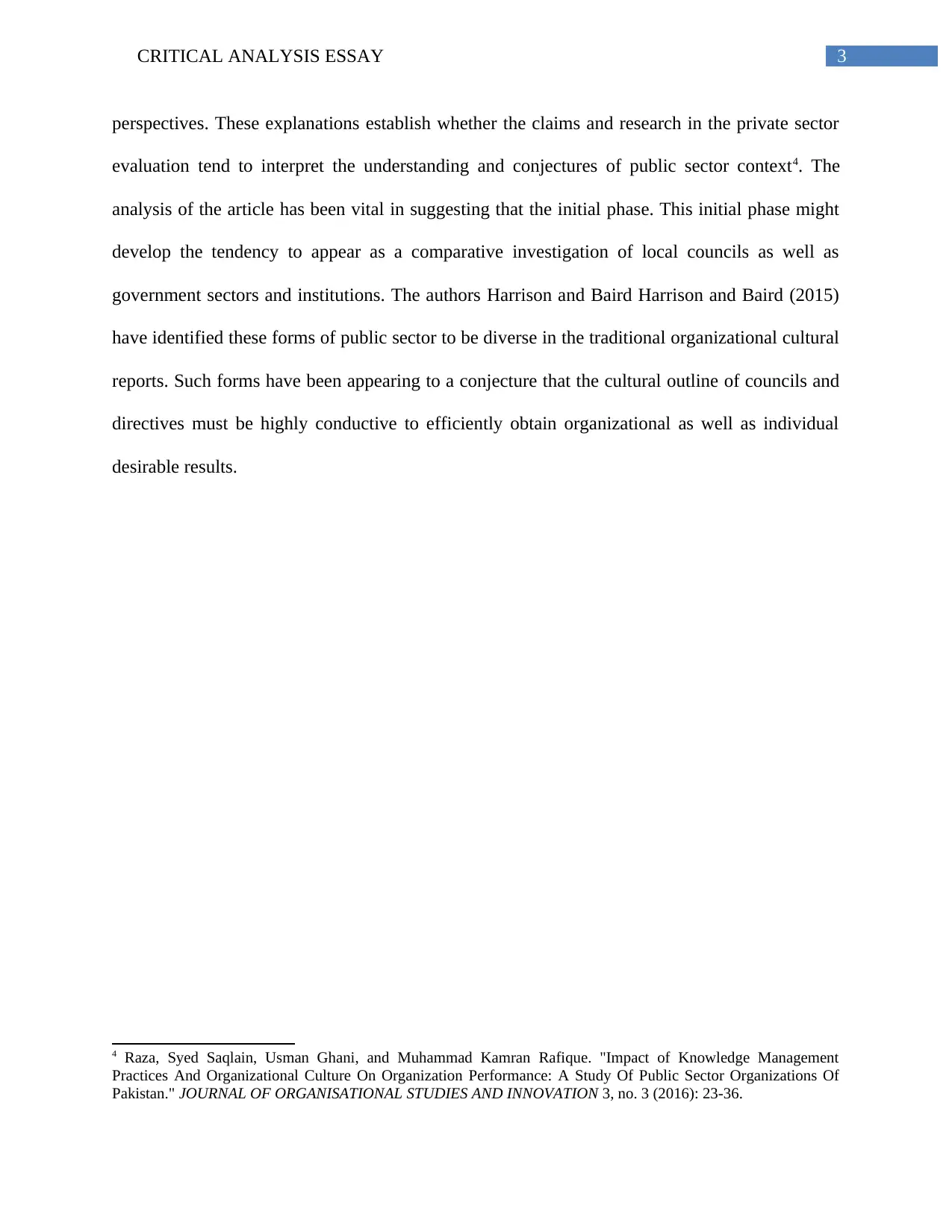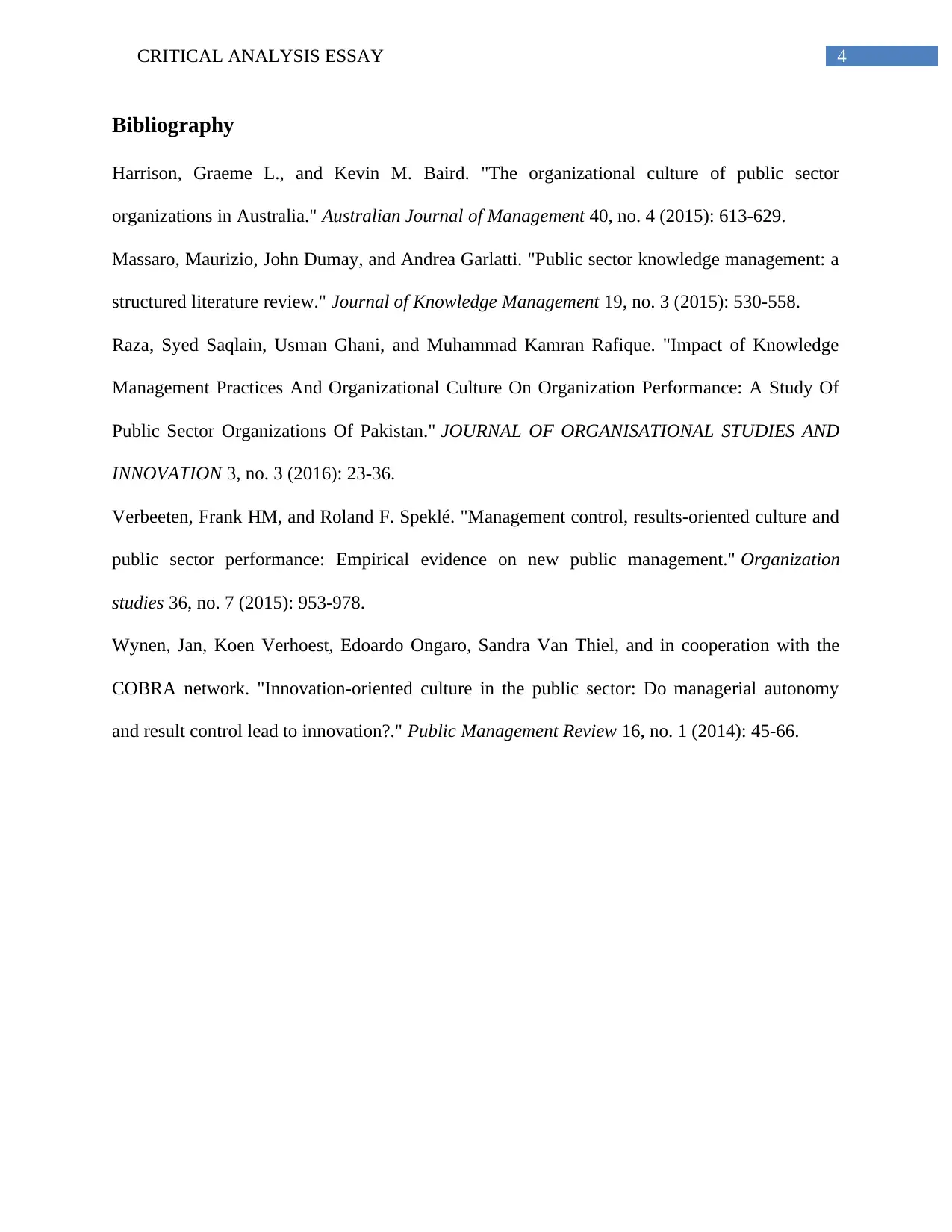Critical Analysis Essay: Public Sector Culture and Management
VerifiedAdded on 2023/06/07
|5
|1130
|500
Essay
AI Summary
This critical analysis essay examines the article "The organizational culture of public sector organizations in Australia" by Harrison and Baird. The essay focuses on the importance of organizational culture in the public sector, particularly within the Australian context. It explores key arguments, such as the impact of outcome orientation and innovation on public sector performance, and the evolution of public sector culture in comparison to the private sector. The essay draws on supporting research from authors like Maurizio, Dumay, and Garlatti, as well as Wynen et al., to provide a comprehensive analysis of the challenges and transformations within public sector management. The essay also considers the limitations of observed evidence and the impact of subcultures and professional allegiances on organizational outcomes. The analysis concludes by suggesting that the initial phase might develop the tendency to appear as a comparative investigation of local councils as well as government sectors and institutions.

Running head: CRITICAL ANALYSIS ESSAY
CRITICAL ANALYSIS ESSAY
Name of the Student:
Name of the University:
Author note:
CRITICAL ANALYSIS ESSAY
Name of the Student:
Name of the University:
Author note:
Paraphrase This Document
Need a fresh take? Get an instant paraphrase of this document with our AI Paraphraser

1CRITICAL ANALYSIS ESSAY
Introduction
The article “The organizational culture of public sector organizations in Australia” by
Harrison and Baird put emphasize on the empirical illustration of the organizational cultural
aspects and determinants of organizations engaged in Australian public sector. The authors
further have mentioned about certain evidences between specific dimensions pertaining to
organizational culture along with a series of both individually as well as organizationally
anticipated outcomes1. Harrison and Baird have drawn thoughts of some scholars in the article on
the aspect of Outcome Orientation which typically comprises of certain organizational values of
being achievement oriented and exhibiting increased level of expectations for performance. The
thesis statement of the essay is “Organizational culture has been perceived as an imperceptible
factor in the sphere of public sector management in recent times”
Discussion
Furthermore, drawing correspondence to Harrison and Baird (2015), authors Maurizio,
Dumay, and Garlatti (2015) indicated that organizational culture is highly significant in the
progress of an organization due to the values and perceptions. As per their perspective, the
values connect an organization and its employees contributing to its development2. Culture as a
highly complex phenomenon has emerged in the process of socialization and in specific
environment. Public sector knowledge management: a structured literature review."Journal of
Knowledge Management” further focused on the way cultural aspects can be justified through
the conceptualization of philosophical, political, and sociological along with several other
1 Massaro, Maurizio, John Dumay, and Andrea Garlatti. "Public sector knowledge management: a structured
literature review." Journal of Knowledge Management 19, no. 3 (2015): 530-558.
2 Wynen, Jan, Koen Verhoest, Edoardo Ongaro, Sandra Van Thiel, and in cooperation with the COBRA network.
"Innovation-oriented culture in the public sector: Do managerial autonomy and result control lead to
innovation?." Public Management Review 16, no. 1 (2014): 45-66.
Introduction
The article “The organizational culture of public sector organizations in Australia” by
Harrison and Baird put emphasize on the empirical illustration of the organizational cultural
aspects and determinants of organizations engaged in Australian public sector. The authors
further have mentioned about certain evidences between specific dimensions pertaining to
organizational culture along with a series of both individually as well as organizationally
anticipated outcomes1. Harrison and Baird have drawn thoughts of some scholars in the article on
the aspect of Outcome Orientation which typically comprises of certain organizational values of
being achievement oriented and exhibiting increased level of expectations for performance. The
thesis statement of the essay is “Organizational culture has been perceived as an imperceptible
factor in the sphere of public sector management in recent times”
Discussion
Furthermore, drawing correspondence to Harrison and Baird (2015), authors Maurizio,
Dumay, and Garlatti (2015) indicated that organizational culture is highly significant in the
progress of an organization due to the values and perceptions. As per their perspective, the
values connect an organization and its employees contributing to its development2. Culture as a
highly complex phenomenon has emerged in the process of socialization and in specific
environment. Public sector knowledge management: a structured literature review."Journal of
Knowledge Management” further focused on the way cultural aspects can be justified through
the conceptualization of philosophical, political, and sociological along with several other
1 Massaro, Maurizio, John Dumay, and Andrea Garlatti. "Public sector knowledge management: a structured
literature review." Journal of Knowledge Management 19, no. 3 (2015): 530-558.
2 Wynen, Jan, Koen Verhoest, Edoardo Ongaro, Sandra Van Thiel, and in cooperation with the COBRA network.
"Innovation-oriented culture in the public sector: Do managerial autonomy and result control lead to
innovation?." Public Management Review 16, no. 1 (2014): 45-66.

2CRITICAL ANALYSIS ESSAY
perspectives. However on the other hand Harrison and Baird (2015) highlighted the areas of
limitations of observed evidences while further revealed the value of organizational culture in
stimulating productivity, success and performance. These factors offer change and amendments
and further enabling implementation of management endeavours.
However it has been noted by Harrison and Baird (2015) that alterations pertaining to the
organizational cultural patterns which tend to internalizes changes in public sector will be
evaluated. Wynen et al. (2014) are of the perspective that certain determinants of public sector
transitions have also been subjective to the perspectives of Drucker on the necessity for a
superior degree of client centre of attention, decentralized structure along with performance
analysis and production orientation. Nevertheless the changing views related to the supreme
representation of public organization have acknowledged the public sector in several nations.
Their primary aim was to modify regulation methods from the hierarchical as well as prescribed
structures of practical organizations to those direct mechanisms which tend to succeed in the
private sector. Additionally the ideas reflected by Harrison and Baird (2015) exhibit that public
sector organizations across the world would encounter condition of instability. These forms of
unsteadiness tend to divert from customary representations of public administration under the
experience of private sector organizations3. Though there can be identified wide range of
hindrances to public sector development which further incorporates the value of significant sub-
cultures. It further involves professional allegiances; public sector enterprises can be anticipated
to gradually represent their private sector rivalries.
Conclusion
Raza et al. (2016) have provided inclusive insights of the associations in public sector
3 Verbeeten, Frank HM, and Roland F. Speklé. "Management control, results-oriented culture and public sector
performance: Empirical evidence on new public management." Organization studies 36, no. 7 (2015): 953-978.
perspectives. However on the other hand Harrison and Baird (2015) highlighted the areas of
limitations of observed evidences while further revealed the value of organizational culture in
stimulating productivity, success and performance. These factors offer change and amendments
and further enabling implementation of management endeavours.
However it has been noted by Harrison and Baird (2015) that alterations pertaining to the
organizational cultural patterns which tend to internalizes changes in public sector will be
evaluated. Wynen et al. (2014) are of the perspective that certain determinants of public sector
transitions have also been subjective to the perspectives of Drucker on the necessity for a
superior degree of client centre of attention, decentralized structure along with performance
analysis and production orientation. Nevertheless the changing views related to the supreme
representation of public organization have acknowledged the public sector in several nations.
Their primary aim was to modify regulation methods from the hierarchical as well as prescribed
structures of practical organizations to those direct mechanisms which tend to succeed in the
private sector. Additionally the ideas reflected by Harrison and Baird (2015) exhibit that public
sector organizations across the world would encounter condition of instability. These forms of
unsteadiness tend to divert from customary representations of public administration under the
experience of private sector organizations3. Though there can be identified wide range of
hindrances to public sector development which further incorporates the value of significant sub-
cultures. It further involves professional allegiances; public sector enterprises can be anticipated
to gradually represent their private sector rivalries.
Conclusion
Raza et al. (2016) have provided inclusive insights of the associations in public sector
3 Verbeeten, Frank HM, and Roland F. Speklé. "Management control, results-oriented culture and public sector
performance: Empirical evidence on new public management." Organization studies 36, no. 7 (2015): 953-978.
⊘ This is a preview!⊘
Do you want full access?
Subscribe today to unlock all pages.

Trusted by 1+ million students worldwide

3CRITICAL ANALYSIS ESSAY
perspectives. These explanations establish whether the claims and research in the private sector
evaluation tend to interpret the understanding and conjectures of public sector context4. The
analysis of the article has been vital in suggesting that the initial phase. This initial phase might
develop the tendency to appear as a comparative investigation of local councils as well as
government sectors and institutions. The authors Harrison and Baird Harrison and Baird (2015)
have identified these forms of public sector to be diverse in the traditional organizational cultural
reports. Such forms have been appearing to a conjecture that the cultural outline of councils and
directives must be highly conductive to efficiently obtain organizational as well as individual
desirable results.
4 Raza, Syed Saqlain, Usman Ghani, and Muhammad Kamran Rafique. "Impact of Knowledge Management
Practices And Organizational Culture On Organization Performance: A Study Of Public Sector Organizations Of
Pakistan." JOURNAL OF ORGANISATIONAL STUDIES AND INNOVATION 3, no. 3 (2016): 23-36.
perspectives. These explanations establish whether the claims and research in the private sector
evaluation tend to interpret the understanding and conjectures of public sector context4. The
analysis of the article has been vital in suggesting that the initial phase. This initial phase might
develop the tendency to appear as a comparative investigation of local councils as well as
government sectors and institutions. The authors Harrison and Baird Harrison and Baird (2015)
have identified these forms of public sector to be diverse in the traditional organizational cultural
reports. Such forms have been appearing to a conjecture that the cultural outline of councils and
directives must be highly conductive to efficiently obtain organizational as well as individual
desirable results.
4 Raza, Syed Saqlain, Usman Ghani, and Muhammad Kamran Rafique. "Impact of Knowledge Management
Practices And Organizational Culture On Organization Performance: A Study Of Public Sector Organizations Of
Pakistan." JOURNAL OF ORGANISATIONAL STUDIES AND INNOVATION 3, no. 3 (2016): 23-36.
Paraphrase This Document
Need a fresh take? Get an instant paraphrase of this document with our AI Paraphraser

4CRITICAL ANALYSIS ESSAY
Bibliography
Harrison, Graeme L., and Kevin M. Baird. "The organizational culture of public sector
organizations in Australia." Australian Journal of Management 40, no. 4 (2015): 613-629.
Massaro, Maurizio, John Dumay, and Andrea Garlatti. "Public sector knowledge management: a
structured literature review." Journal of Knowledge Management 19, no. 3 (2015): 530-558.
Raza, Syed Saqlain, Usman Ghani, and Muhammad Kamran Rafique. "Impact of Knowledge
Management Practices And Organizational Culture On Organization Performance: A Study Of
Public Sector Organizations Of Pakistan." JOURNAL OF ORGANISATIONAL STUDIES AND
INNOVATION 3, no. 3 (2016): 23-36.
Verbeeten, Frank HM, and Roland F. Speklé. "Management control, results-oriented culture and
public sector performance: Empirical evidence on new public management." Organization
studies 36, no. 7 (2015): 953-978.
Wynen, Jan, Koen Verhoest, Edoardo Ongaro, Sandra Van Thiel, and in cooperation with the
COBRA network. "Innovation-oriented culture in the public sector: Do managerial autonomy
and result control lead to innovation?." Public Management Review 16, no. 1 (2014): 45-66.
Bibliography
Harrison, Graeme L., and Kevin M. Baird. "The organizational culture of public sector
organizations in Australia." Australian Journal of Management 40, no. 4 (2015): 613-629.
Massaro, Maurizio, John Dumay, and Andrea Garlatti. "Public sector knowledge management: a
structured literature review." Journal of Knowledge Management 19, no. 3 (2015): 530-558.
Raza, Syed Saqlain, Usman Ghani, and Muhammad Kamran Rafique. "Impact of Knowledge
Management Practices And Organizational Culture On Organization Performance: A Study Of
Public Sector Organizations Of Pakistan." JOURNAL OF ORGANISATIONAL STUDIES AND
INNOVATION 3, no. 3 (2016): 23-36.
Verbeeten, Frank HM, and Roland F. Speklé. "Management control, results-oriented culture and
public sector performance: Empirical evidence on new public management." Organization
studies 36, no. 7 (2015): 953-978.
Wynen, Jan, Koen Verhoest, Edoardo Ongaro, Sandra Van Thiel, and in cooperation with the
COBRA network. "Innovation-oriented culture in the public sector: Do managerial autonomy
and result control lead to innovation?." Public Management Review 16, no. 1 (2014): 45-66.
1 out of 5
Related Documents
Your All-in-One AI-Powered Toolkit for Academic Success.
+13062052269
info@desklib.com
Available 24*7 on WhatsApp / Email
![[object Object]](/_next/static/media/star-bottom.7253800d.svg)
Unlock your academic potential
Copyright © 2020–2025 A2Z Services. All Rights Reserved. Developed and managed by ZUCOL.


